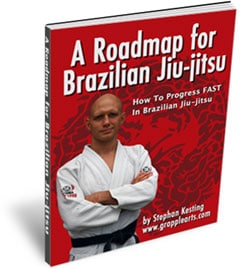A reader writes:
Q: “I would like to hear you address grappling with no formal teacher or school. What are the benefits/downsides to this? What should we be careful to avoid? This is the situation I am in now, I get to practice with some good guys but have actually never had formal training. “
A: Let’s start my answer with a story:
Back in the late 1980’s I was training in Emperado-method Kajukenbo Karate under Philip Gelinas. At this time BJJ was still incredibly rare, but I came across the old Gracie in Action videos. By watching the fights on these videos three things immediately became clear:
- That sitting on top of someone was a good place to be (i.e. the mount)
- If you were on the bottom you wanted to wrap your legs around your opponent’s torso (i.e the guard)
- That twisting or hyperextending someone’s arms, legs or neck could force them to give up (i.e. jointlocks and chokes).
Now this was scarcely the most sophisticated analysis of BJJ strategy, but armed with these three nuggets my training partners and I started hitting the mats. In our group we had some Judo, Shooto, wrestling and traditional japanese jiu-jitsu knowledge, but nothing high level, and certainly nothing formal.
Our sparring sessions at the time included hair-pulling, eye-gouging and finger-twisting: it’s a miracle that nobody was severely injured. Nevertheless, we made a lot of progress and had a lot of fun.
I give this early training a lot of credit, because we were still trying to control opponents who didn’t want to be controlled, and trying to submit training partners who were trying to submit us in return. I am forever grateful to Philip Gelinas for permitting, nurturing and encouraging these rough and tumble sessions.
A few years later I started studying grappling more formally, under a variety of instructors (Marcus Soares, Pshemek Drabchinsky, Erik Paulson, Walter Lanz and Joe McCarthy). I think that the informal training I had done earlier had laid a good foundation, and I quickly soaked up knowledge like a sponge. So YES, I believe that most people can make good progress in grappling without frequent access to a ‘proper’ instructor.
Even though instructor-less progress is possible, I think that most people will benefit from having access to a formal coach, even if they only see him once or twice a year. This becomes more important as the person tries to move from being a beginner to an intermediate or advanced level grappler, because a coach-type figure might be able to see holes in your game that your sparring partners cannot.
If you can’t actually go and train under a formal coach then at least get some sparring time with formally trained people once in a while. Even if this only happens every 3 or 4 months it will help you to gauge the effectiveness of your training and prevent you from living in a dreamworld with regard to your skill level.
Also, if you’re serious about learning BJJ or grappling without an instructor to guide you, then I can’t recommend signing up for my free Beginning BJJ newsletter strongly enough.
Not only do you get a ton of great tips, tricks and techniques emailed to you, you also get to download my book A Roadmap for BJJ entirely for free. Click here for more info on the Beginning BJJ newsletter.
The post Teacherless Training appeared first on Grapplearts.

